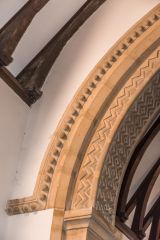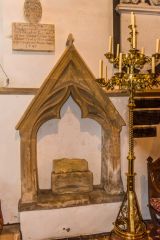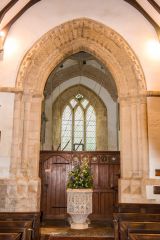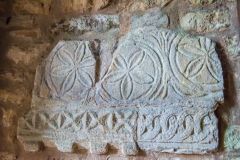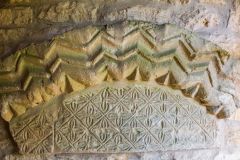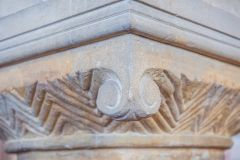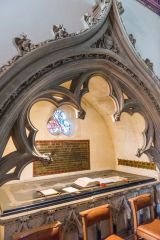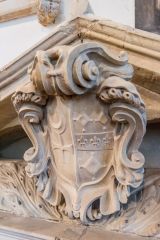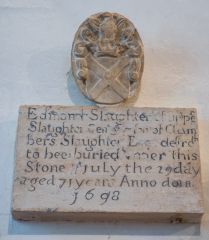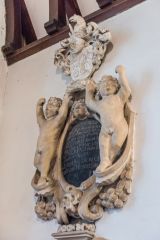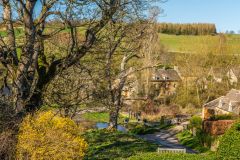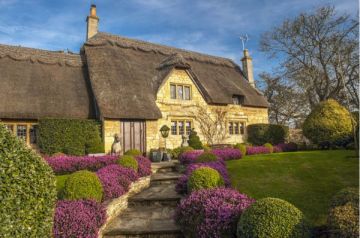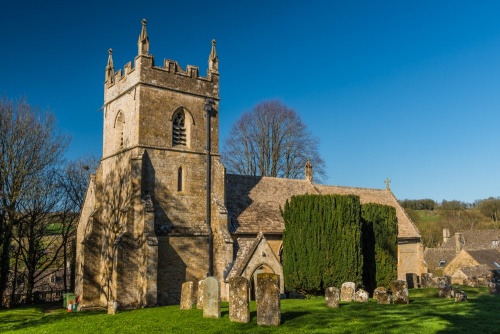
Upper Slaughter is one of the most picturesque and idyllic villages in the Cotswolds. In the centre of the village, occupying a rise above the River Eye, stands the early medieval church of St Peter. The dedication appears to date to 1803; we know that the church was known as St Mary's in 1403.
History
There has been a church on this spot since at least the 12th century and possibly as early as the 11th century. The first rector is recorded in 1251 and appears to have been an Italian.
The parish seems to have had some interesting rectors over the centuries; In the 14th century, three rectors in a row had permission to be absent from the benefice (i.e. they were absentee rectors).
Later that century the rector was a notable 'chopchurch', that is, he was known to exchange benefices with other rectors. 'Chopping' was the practice of buying and selling benefices to the highest bidder, or in some cases, trading benefices between rectors for personal gain.
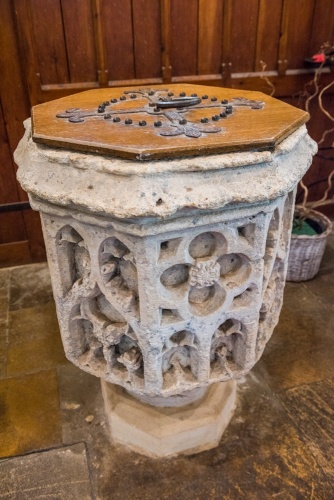
One Tudor rector was removed from his living in 1554 under Queen Mary only to be restored in 1559 under Elizabeth I. He got into trouble a decade later when it was found that his house and the chancel were in poor repair and his servant was pregnant (presumably with his child).
Things improved in the 18th century and from 1764-1913 the church was served by only four rectors. That's a span of 149 years shared between just four rectors.
The Church Building
The building we see today is mainly 12th-century, with extensive restoration in 1877. Thankfully, the restoration re-used most of the original medieval stonework. It comprises a nave, chancel, west tower, south porch, north chapel, and north aisle.
The tower is built into the south-west corner of the nave, while the north aisle runs the entire length of the nave. Saxon stonework is incorporated into the lower part of the tower's west wall. A small rounded window in the tower is thought to date to the 11th century.
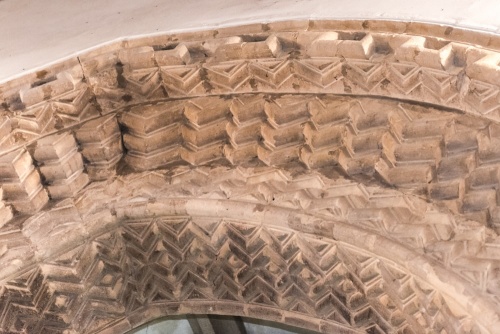
The north arcade dates to the middle of the 12th century. It may have been inserted after the church suffered an attack around 1145, during the turmoil of The Anarchy, the devastating Civil War between King Stephen and Queen Maud.
Maud's half-brother Robert, 1st Earl of Gloucester, was one of her military leaders during the war and owned territory in this region. The church suffered considerable damage in the fighting.
The intricately carved tower arch was quite obviously made for a broader tower; it has been adapted to fit the narrower opening of the present arched opening.
The tower arch is carved in three orders with traditional chevron patterns and rests on beautifully carved corbels. Curiously, the carving is typical of the 12th century, but the arch is pointed, a style that did not develop until the following century.
Compare the authentic medieval tower arch and its ornate carving with the chancel arch, in a similar style but very much a Victorian copy of the original designs.
Under the tower arch is a deeply cut 15th-century font. It is so large that it may have originally been a 12th-century tub font, cut down in the late medieval period to its current shape. The carving is very worn, which is not surprising when you consider that from 1877 it stood in the churchyard for 20 years before it was brought back inside the church.
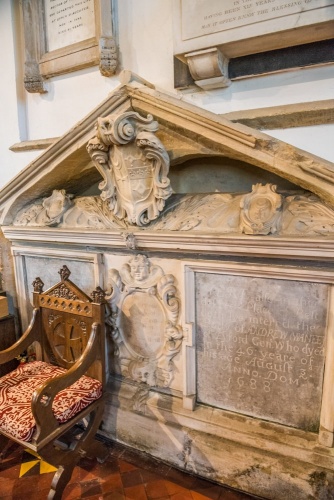
In the chancel is a 13th-century piscina, while also on the south wall is a 14th-century sedilia, or clergy seat, in a triangle-headed niche. Several pieces of a medieval tomb lie in the recess. Opposite the sedilia is a 14th-century recess in the north wall, into which has been inserted the richly carved tomb of Frances and Andrew Wanley of Eyford, dated 1682. The recessed opening is thought to have been made for an Easter Sepulchre.
On the south chancel wall are three Elizabethan brass plaques to members of the Slaughter family, the oldest of which dates to 1583. On the wall above is a tablet to Edmond Slaughter, who died in 1698. Another 17th-century monument is on the south wall of the sanctuary. In the north chapel is the very ornate tomb of Rev Francis Edward Witts (1783-1854), almost dwarfed within a massive Gothic niche.
Look for pieces of a medieval tympanum set on the wall of the south porch as you enter. The tympanum and sections of a chevron-incised arch would have formed part of the original 12th-century doorway arch.
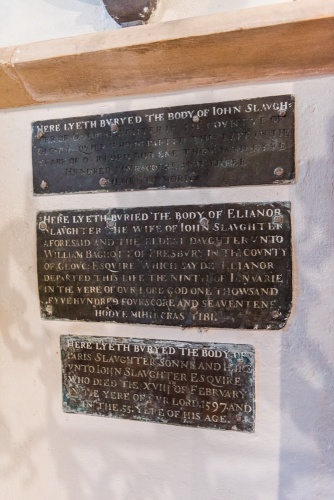
St Peter's is a delightful church, full of historical interest and set in an incredibly beautiful location. The church is usually open to visitors. Don't miss the ancient almshouses beside the church.
On a personal note, our family takes frequent walks through Upper Slaughter and over the fields to Lower Slaughter. We have visited St Peter's Church several times and always come away struck by the sheer beauty of the location and the lingering aura of history. The 12th-century carvings on the tower arch are staggeringly good, and the mix of the Easter Sepulchre, Tudor brasses, and 17th-century memorials make the church a wonderful place to explore.
About Upper Slaughter, St Peter
Address: The Square,
Upper Slaughter,
Gloucestershire,
England, GL54 2JE
Attraction Type: Historic Church
Location: In the centre of the village. Parking around The Square.
Website: Upper Slaughter, St Peter
Location
map
OS: SP154232
Photo Credit: David Ross and Britain Express
HERITAGE
 We've 'tagged' this attraction information to help you find related historic attractions and learn more about major time periods mentioned.
We've 'tagged' this attraction information to help you find related historic attractions and learn more about major time periods mentioned.
Find other attractions tagged with:
NEARBY HISTORIC ATTRACTIONS
Heritage Rated from 1- 5 (low to exceptional) on historic interest
Upper Slaughter Manor - 0.2 miles (Historic House) ![]()
Bourton-on-the-Water, St Lawrence Church - 1.7 miles (Historic Church) ![]()
Salmonsbury Camp - 1.9 miles (Prehistoric Site) ![]()
Naunton Dovecote - 2.4 miles (Historic Building) ![]()
Upper Swell, St Mary's Church - 2.6 miles (Historic Church) ![]()
Naunton, St Andrew's Church - 2.6 miles (Historic Church) ![]()
Cold Aston, St Andrew's Church - 2.7 miles (Historic Church) ![]()
Stow-on-the-Wold, St Edward's Church - 2.7 miles (Historic Church) ![]()
Nearest Holiday Cottages to Upper Slaughter, St Peter:
Lower Slaughter, Gloucestershire
Sleeps: 6
Stay from: £964 - 4851
Lower Slaughter, Gloucestershire
Sleeps: 8
Stay from: £1233 - 4617
Bourton-on-the-Water, Gloucestershire
Sleeps: 9
Stay from: £1201 - 5295
More self catering near Upper Slaughter, St Peter
